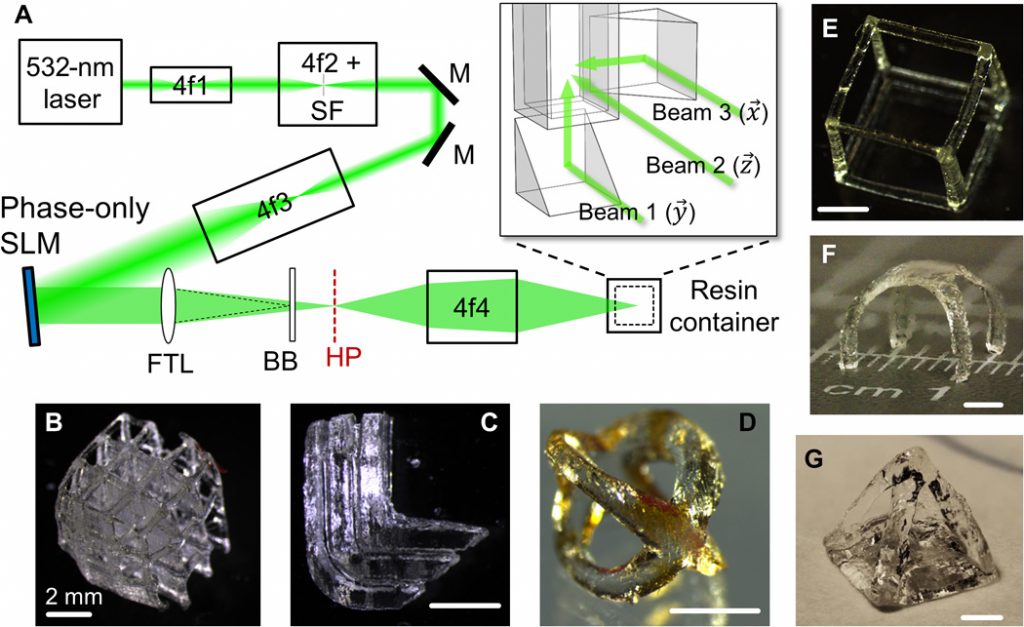Volumetric 3D printing, also known as hologram 3D printing, has the potential to expedite light-based additive manufacturing in a way never seen before. The power of the process lies in its ability to cure objects in a single step, abandoning the use of support structures and the typical layer-by-layer approach.
The method is the subject of an ongoing study at Lawrence Livermore National Laboratory (LLNL) in collaboration with UC Berkley, the Massachusetts Institute of Technology (MIT) and the University of Rochester. In a new article published in Science Advances researchers Maxim Shusteff, Allison E. M. Browar, Brett E. Kelly, Johannes Henriksson, Todd H. Weisgraber, Robert M. Panas, Nicholas X. Fang, and Christopher M. Spadaccini report on the progress of their holographic approach.
Beyond science fiction
Volumetric 3D printing works by directing three beams of light into a focal point within a tall vat of light-reactive resin. Alone, the beams aren’t strong enough to cure the resin. Combined, the point where the beams meet generates enough energy to solidify the material into a chosen shape.

The paper’s co-author, LLNL engineer and 3D printing lead Chris Spadaccini, explains, “It’s a demonstration of what the next generation of additive manufacturing may be,”
“Most 3D printing and additive manufacturing technologies consist of either a one-dimensional or two-dimensional unit operation. This moves fabrication to a fully 3D operation, which has not been done before.”
Space for limitations
A method still in its infancy the process has some limitations to the geometry, resolution, and scale of the finished parts. Extremely intricate structures, like highly detailed jewelry, would require more intersecting light beams, adding unnecessary complexity to the process that would ultimately limit production. Added beams means would require more sophisticated heat and exposure management.
Two areas volumetric 3D printing has real potential though are medicine, to make hydrogels, and fabrication under micro-gravity conditions.
Spadaccini adds, “The potential impact on throughput could be enormous, and if you can do it well you can still have a lot of complexity.”

Leave out the layers
The researchers point out that using holograms “might be the only way to do AM that doesn’t require layering.” By eradicating layers the process avoids caveats, such as ridges, optical quality and directional properties, associated with typical SLA or DLP.
LLNL researcher and lead author Maxim Shusteff, explains, “The fact that you can do fully 3D parts all in one step really does overcome an important problem in additive manufacturing.”
“…I’m hoping what this will do is inspire other researchers to find other ways to do this with other materials. It would be a paradigm shift.”
In the interests of the DOE
Volumetric 3D printing research by Shusteff et al. has been funded by a Laboratory Directed Research and Development (LDRD) grant. LDRD grants are awarded to national laboratories by the U.S. Department of Energy (DOE), supporting “high-risk, high-reward” projects that fulfil five primary directives including enhancement of “the laboratories’ ability to address future DOE/NNSA missions,” and those that foster “creativity and stimulate exploration of forefront science and technology.”
At this stage, Shusteff stipulates that, “The real aim of this paper was to ask, ‘Can we make arbitrary 3D shapes all at once, instead of putting the parts together gradually layer by layer?'”
He adds, “It turns out we can.”
Subscribe to the 3D Printing Industry newsletter, like us Facebook and follow us on Twitter to stay up to date with all the latest additive news.
Nominate leading research projects and more in the second annual 3D Printing Industry Awards.
Featured image shows small cube and pyramid skeletons made using volumetric 3D printing. Photo via LLNL


